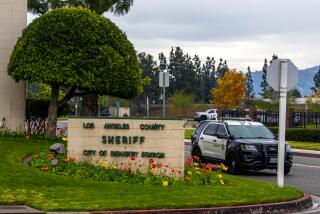Oklahoma deputy who mistook gun for Taser not properly trained, report says
Two high-ranking members of the Tulsa County Sheriff’s Department created a culture of intimidation that allowed the wealthy reserve deputy involved in a controversial police shooting earlier this month to advance through the ranks without proper training, according to an internal report made public Friday.
The nearly 300-page document, released Friday by the attorneys of the man shot and killed by Reserve Deputy Robert Bates, contains interviews with several sheriff’s officers who said they were repeatedly threatened by Sheriff’s Department Chief Tim Albin and Capt. Tom Huckeby for criticizing Bates.
“Policy has been violated, and continues to be violated, by both Captain Tom Huckeby and Chief Deputy Tim Albin with regard to special treatment shown to Reserve Deputy Robert Bates with regard to his field training, and with Captain Huckeby and Chief Albin creating an atmosphere in which employees were intimidated to fail to adhere to policies in a manner which benefits Reserve Deputy Bates,” the author wrote in the report’s conclusion.
The report was compiled in 2009. Clark Brewster, the attorney representing Bates, said the 6-year-old report had no bearing on the April 2 shooting, in which the reserve deputy shot and killed Eric Harris when he mistook his Taser for a handgun.
Brewster said there was confusion over the amount of training Bates needed because, unlike other reserve deputies, he had previously served as a police officer in Tulsa.
“Bob Bates had received academy training and had been a police officer 25 years earlier. ... He could have been a local town chief if he wanted, no problems,” Brewster said. “He was different than the others and they didn’t really know how to deal with him.”
In a short statement, an attorney for the Sheriff’s Department said the release of the document was unauthorized and added that the existence of the internal report highlights the department’s willingness to investigate allegations of misconduct.
Bates, 73, shot Harris during an undercover sting. The reserve deputy fired one shot, killing Harris, who was unarmed and struggling with another officer on the ground. Bates has been charged with manslaughter and faces up to four years in prison.
Bates contended he reached for his stun gun, and can be heard yelling “Taser” in video of the incident, but accidentally reached for his firearm. In an interview with the “Today” show last week, Bates demonstrated what happened during the shooting, but his explanation drew skepticism from law enforcement experts who spoke with the Los Angeles Times.
Many have criticized Bates’ ties to Tulsa County Sheriff Stanley Glanz. Bates, a wealthy insurance executive, frequently donated cars and other equipment to the Sheriff’s Department.
The internal report cites several examples when Bates conducted police actions, including traffic stops, which he was not trained to do. At one point, the sergeant in charge of the reserve deputy program told Bates he needed to complete additional training before he could work in the field on his own.
“Well, I can do it, and if you don’t like it, you can talk to Tim Albin or Sheriff Glanz because I’m going to do it,” Bates said in reply, according to the report.
Another officer told an internal affairs investigator that he was ordered to sign memos, which he did not write, showing Bates had successfully completed certain training programs.
At one point in that interview, the investigator asked Cpl. Warren Crittendon if he believed Bates was “capable of functioning in the field.”
“Nope,” Crittendon replied, according to the report.
It was not clear if Albin or Huckeby faced disciplinary action, though an attorney for Harris’ family told The Times they did not. Multiple calls and emails to the Sheriff’s Department were not returned.
“They continued to allow Bates to do whatever he wanted. What’s so crazy is they allowed this guy, just because of money, essentially to take over the entire Sheriff’s Department,” said Dan Smolen, attorney for the Harris family.
Smolen said Harris would be alive today if the Sheriff’s Department had forced Bates to adhere to its training policies.
“If it had been handled in 2009 or in 2010, ‘11, ‘12, ‘13, ’14 and ‘15,” Smolen said, “if they had just acted on their own policies and procedures, it could have been prevented.”
After the internal report was filed, Bates completed all necessary training to function as a reserve deputy in Tulsa County, Brewster said. He now has a good relationship with many of the officers quoted in the internal report, according to Brewster.
Generally speaking, Bates’ job did not require him to be involved in arrests or other patrol functions. Brewster said Bates normally took fingerprint kits and other equipment related to evidence collection to crime scenes.
“It wasn’t ideal that this man was trying to come to the aid of the officers this guy was fighting with. It would have been better had that not occurred,” Brewster said. “It would have been better had this guy been arrested at the scene when he bolted from the car. [Bates] was placed in a situation that was extraordinary.”
The Tulsa County district attorney’s office subpoenaed the records on Thursday, according to Smolen. In a brief statement released Friday, Dist. Atty. Stephen A. Kunzweiler said his office was widening its investigation into Harris’ shooting.
“I am highly concerned about recent allegations that have surfaced and I have been in contact with independent law enforcement agencies regarding further investigation into these matters,” he said in a brief statement.
Earlier this week, the FBI cleared the department of violating Harris’ civil rights.
Follow @JamesQueallyLAT on Twitter for breaking news.
More to Read
Start your day right
Sign up for Essential California for news, features and recommendations from the L.A. Times and beyond in your inbox six days a week.
You may occasionally receive promotional content from the Los Angeles Times.







